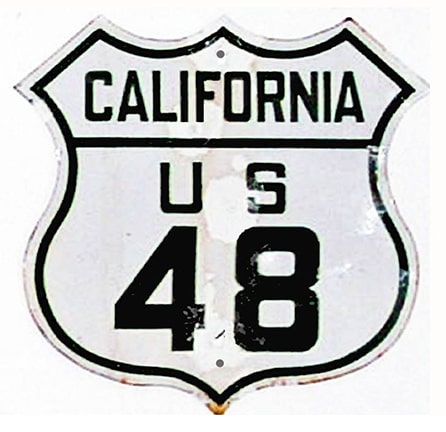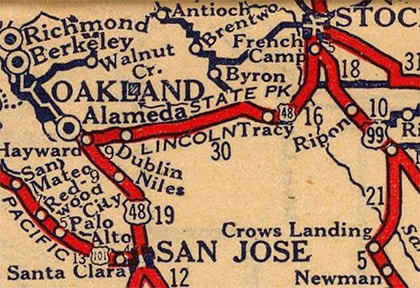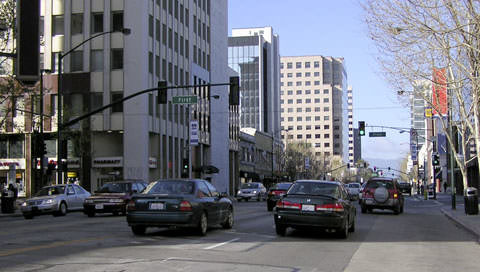End of historic US highway 48 [i]
|
|
(Note: not to be confused with US 48 [ii], which served Maryland and West Virginia during the 1970s and '80s, nor the current US 48, serving Virginia and West Virginia.). Claim to fame: US 48 was the shortest-ever two-digit US route; this image is an excerpt from AASHO's Apr. 1927 route log:
|
|
This interactive image was taken heading south out of Stockton on French Camp Road, which was once US 99:
|
|
Just past the railroad crossing is the original settlement of French Camp. To the right on Harlan Road was the original east beginning of US 48. But that did not last long: in about 1929 this junction was redesignated as a split in US 99. Straight ahead was US 99E (the more direct route to Manteca), while the former US 48 to the right became US 99W (which passed through Lathrop). The curve where US 99W turned east on Yosemite Avenue (to rejoin US 99 in Manteca) became the eastern terminus of US 48. That historic road junction has been unalterably changed by the more recent I-5/CA 120 interchange, but this image shows the site:
|
That is looking northeast on Manthey Road, or historic US 48. Originally that designation continued to the left, up to French Camp. But in 1929 this became the east end of US 48. If a driver continued on the road to French Camp, they would have been on northbound US 99W. Or they could veer to the right: that was southbound US 99W. Today that is just a recreational trail, but historically that was Yosemite Av, which went straight into downtown Manteca, where there was a junction with US 99 and US 99E.
Heading the opposite direction, the US 48 designation continued south and west to the location shown here: |
That was in San Jose, looking west on Santa Clara Boulevard at First Avenue. US 48 probably ended there; ahead was northbound US 101, and southbound 101 was to the left. However, it is unknown when Market Street was configured to serve as a "bypass" of First. If it was during the time of US 48's brief existence, then US 48 would have ended one block further ahead, at Market.
|
Also in about 1929, US 101 split into 101E and 101W at that intersection. US 101E went north to Hayward via what had been US 48, so US 48's south end was truncated to Hayward. US 48 was completely decommissioned in 1931, but during that brief two-year period, it was the shortest-ever two-digit US route, at just 50 miles. This excerpt is from AASHO's 1929 route log:
|
Research and/or photo credits: Matthew Anderson; Nathan Edgars; Chris Elbert; Tom Fearer; Dale Sanderson; Michael Summa
Page originally created 2005;
last updated Jun. 20, 2023.
last updated Jun. 20, 2023.






